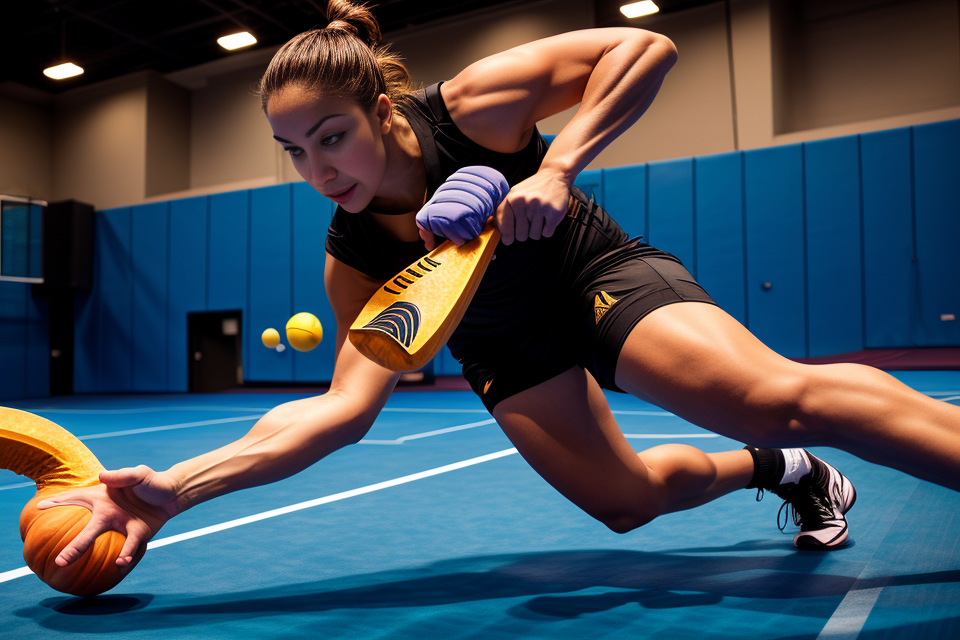Squash is a sport that requires agility, strength, and endurance. It is a high-intensity aerobic activity that provides numerous health benefits. It is a low-impact sport that is easy on the joints and can be played by people of all ages and fitness levels. In this article, we will explore how squash can help improve your health. We will focus on the physical benefits of squash, specifically how it can help improve the health of different parts of your body. Whether you are a beginner or an experienced player, squash is a great way to stay fit and healthy. So, let’s get started and discover how squash can help improve your health.
Squash is a high-intensity, aerobic sport that can help improve cardiovascular health, increase endurance, and burn calories. Playing squash regularly can also help improve hand-eye coordination, balance, and flexibility. Additionally, squash is a non-impact sport, which means it is easier on the joints compared to high-impact sports like running. Furthermore, playing squash can also help relieve stress and improve mental well-being. Overall, incorporating squash into your fitness routine can provide a full-body workout and improve your overall health and well-being.
Understanding the Benefits of Squash
Cardiovascular Health
Squash is a physically demanding sport that requires players to run, jump, and change direction rapidly. As a result, playing squash can have a positive impact on cardiovascular health. Cardiovascular health refers to the health of the heart and blood vessels, and it is essential for maintaining overall physical health.
Here are some ways in which squash can improve cardiovascular health:
- Increases Endurance: Squash is a high-intensity sport that requires players to be physically fit. Playing squash regularly can help improve endurance, which is essential for cardiovascular health. Endurance is the ability of the heart and blood vessels to deliver oxygen and nutrients to the muscles during physical activity. The more endurance you have, the more efficiently your heart and blood vessels can function, which can lead to improved cardiovascular health.
- Lowers Blood Pressure: High blood pressure is a major risk factor for cardiovascular disease. Playing squash regularly has been shown to lower blood pressure, which can help reduce the risk of cardiovascular disease. The physical demands of squash can help strengthen the heart and blood vessels, which can lead to improved cardiovascular health.
- Improves Cholesterol Levels: High levels of LDL cholesterol (the “bad” cholesterol) can increase the risk of cardiovascular disease. Playing squash regularly has been shown to improve cholesterol levels, which can help reduce the risk of cardiovascular disease. The physical demands of squash can help improve cholesterol levels by increasing the number of LDL receptors in the blood vessels, which can help remove LDL cholesterol from the bloodstream.
- Reduces Inflammation: Inflammation is a natural response by the body’s immune system to injury or infection. Chronic inflammation can contribute to the development of cardiovascular disease. Playing squash regularly has been shown to reduce inflammation, which can help reduce the risk of cardiovascular disease. The physical demands of squash can help reduce inflammation by reducing the production of cytokines, which are pro-inflammatory molecules.
Overall, playing squash regularly can have a positive impact on cardiovascular health. The physical demands of squash can help improve endurance, lower blood pressure, improve cholesterol levels, and reduce inflammation, which can all contribute to improved cardiovascular health.
Respiratory Function
Squash is a physically demanding sport that requires players to move around the court rapidly, run, jump, and change direction quickly. These movements are not only essential for the success of the game but also provide significant benefits to the player’s respiratory system.
One of the most significant benefits of playing squash is the improvement in lung capacity. The constant running, jumping, and sudden changes in direction during a game increase the amount of oxygen required by the body. This leads to an improvement in lung capacity, allowing players to take in more oxygen and therefore, enhance their endurance levels.
Moreover, squash also helps to improve the functioning of the lungs and respiratory system by increasing the rate at which air is exchanged in the lungs. This results in better oxygenation of the blood, which is crucial for overall health and fitness.
Furthermore, squash has been found to help those suffering from asthma by improving their lung function. Playing squash regularly has been shown to reduce the severity of asthma symptoms and improve the overall quality of life for those affected.
Overall, playing squash regularly can improve respiratory function, increase lung capacity, and enhance overall health and fitness.
Coordination and Balance
Squash is a sport that requires a high level of coordination and balance. These skills are essential for moving around the court, hitting the ball, and preventing falls. Here are some ways in which squash can improve your coordination and balance:
- Footwork: Squash involves a lot of running and changing direction quickly. This requires good footwork, which can be improved through practice. As you move around the court, you will need to use your feet to position yourself correctly for each shot. The more you play, the better your footwork will become, and the more confident you will feel on the court.
- Hand-Eye Coordination: Squash also requires good hand-eye coordination, as you need to hit the ball with precision and accuracy. This skill can be improved by practicing your swings and focusing on your target. As you become more comfortable with the movements involved in hitting the ball, your hand-eye coordination will improve, and you will be able to hit the ball more consistently.
- Balance: Squash can also help improve your balance, as you need to move around the court while maintaining your footing. This is particularly important when hitting the ball, as you need to be able to shift your weight and maintain your balance to make a successful shot. Playing squash regularly can help improve your balance and prevent falls, particularly as you get older.
Overall, squash is a great way to improve your coordination and balance. Whether you are a beginner or an experienced player, you can benefit from the physical and mental challenges that squash provides. By improving your coordination and balance, you will be able to move more effectively around the court, hit the ball with greater precision, and prevent falls.
Squash and Muscle Strength
Core Strength
Squash is a physically demanding sport that requires quick reflexes, agility, and strength. Playing squash regularly can help improve muscle strength, particularly in the core muscles. The core muscles include the muscles of the abdomen, lower back, hips, and pelvis. These muscles are essential for maintaining good posture, balance, and stability.
There are several ways in which squash can help improve core strength. Firstly, the constant movement and changing direction required in squash can help improve balance and stability. This is because the core muscles are used to stabilize the body during movement.
Secondly, squash involves hitting a small rubber ball against a wall, which requires quick and precise movements. These movements can help improve the strength and endurance of the core muscles. For example, hitting a shot that requires a rapid change of direction can help strengthen the obliques, which are the muscles that run along the sides of the abdomen.
Lastly, squash involves a lot of jumping and lunging, which can help improve lower back strength. The lower back muscles are an important part of the core and are used to stabilize the spine during movement. By regularly playing squash, these muscles can become stronger and more resilient.
Overall, playing squash can be an effective way to improve core strength and overall physical fitness. By incorporating squash into your regular exercise routine, you can improve your muscle strength, balance, and stability, which can have a positive impact on your overall health and wellbeing.
Upper Body Strength
Squash is a physically demanding sport that requires quick reflexes, agility, and endurance. Playing squash regularly can significantly improve your upper body strength, providing you with numerous health benefits.
- Building Core Strength: Squash involves a lot of jumping, running, and sudden changes in direction, which can help build core strength. A strong core helps maintain proper posture, balance, and stability, reducing the risk of injury.
- Increasing Upper Body Power: Squash involves hitting a small rubber ball against a wall with a racquet, which requires a significant amount of power in the upper body. Regular squash play can help increase shoulder, arm, and back strength, resulting in improved muscle endurance and overall fitness.
- Improving Hand-Eye Coordination: Squash is a fast-paced sport that requires excellent hand-eye coordination. The constant movement and ball-hitting action can help improve this skill, which can also benefit other aspects of your life, such as sports and work.
- Burning Calories: Squash is a high-intensity sport that can burn a significant number of calories. According to research, a 150-pound person can burn around 500 calories during a single squash game lasting one hour. This can help with weight loss and overall fitness.
- Reducing Stress: Squash is a physically demanding sport that requires focus and concentration. Playing squash can help reduce stress and anxiety, providing mental health benefits.
Overall, playing squash regularly can help improve your upper body strength, providing numerous health benefits. It can also be a fun and enjoyable way to stay fit and healthy.
Leg Strength
Squash is a physically demanding sport that requires quick movements and changes of direction, making it an excellent exercise for improving leg strength. The repetitive movements involved in squash, such as running, jumping, and turning, engage various muscle groups in the legs, including the quadriceps, hamstrings, calves, and glutes.
One of the main benefits of playing squash is the improvement in leg strength, which can help increase overall athletic performance. Strong leg muscles are essential for maintaining balance, stability, and mobility, which are crucial for optimal physical function. In addition, strong leg muscles can help reduce the risk of injury and improve sports-specific skills, such as acceleration, deceleration, and change of direction.
Furthermore, leg strength is essential for everyday activities, such as walking, climbing stairs, and carrying groceries. Having strong leg muscles can also improve posture, reduce the risk of falls, and increase overall confidence in physical activities.
In conclusion, incorporating squash into your fitness routine can provide numerous benefits for leg strength, including improved athletic performance, reduced risk of injury, and better overall physical function. Whether you are a professional athlete or just starting out, squash can be an excellent exercise for improving leg strength and overall health.
Squash and Mental Health
Stress Relief
Squash is a sport that is not only physically demanding but also mentally stimulating. Playing squash can help relieve stress and improve mental health in several ways.
Firstly, squash is a sport that requires split-second decision making and quick thinking. This mental stimulation can help improve cognitive function and increase brain activity. By engaging in regular physical activity, such as playing squash, it can also help reduce the risk of developing conditions such as dementia and Alzheimer’s disease.
Additionally, playing squash can help reduce stress levels by providing an outlet for physical exertion and emotional release. The fast-paced nature of the sport can help take your mind off of daily stressors and provide a much-needed break from the pressures of daily life.
Furthermore, playing squash with others can also provide a sense of community and social connection. This can help improve overall well-being and provide a support system for those struggling with mental health issues.
Overall, incorporating squash into your regular exercise routine can have numerous benefits for both your physical and mental health. Whether you’re looking to improve your physical fitness or simply need a break from daily stressors, squash can provide a fun and engaging way to improve your overall well-being.
Improved Focus and Concentration
Squash is a physically demanding sport that requires split-second decision making and strategic thinking. As a result, playing squash can help improve focus and concentration.
- Boosts Brain Function: Squash is a sport that requires quick reactions and mental agility. It can help improve cognitive function and increase reaction times.
- Improves Problem-Solving Skills: Squash involves making strategic decisions on the fly, which can help improve problem-solving skills.
- Enhances Hand-Eye Coordination: Squash involves hitting a small, fast-moving ball with a racquet, which requires excellent hand-eye coordination. This skill can transfer to other areas of life, such as work or hobbies.
- Reduces Stress: Playing squash can be a great way to reduce stress and improve overall mental health. The physical activity and social interaction can help improve mood and reduce feelings of anxiety and depression.
Overall, playing squash can help improve focus, concentration, and mental health. It’s a great way to stay active and healthy while also having fun and socializing with others.
Increased Self-Confidence
Squash is a sport that can provide numerous benefits for both physical and mental health. One of the key advantages of playing squash is the increased self-confidence that it can bring. This benefit is closely linked to the other mental health advantages of squash, such as improved concentration and reduced stress levels.
Here are some of the ways in which squash can help increase self-confidence:
- Competitive Environment: Squash is a highly competitive sport that requires mental and physical strength. Playing against other players can help build self-confidence by pushing you to perform at your best and challenge yourself.
- Personal Achievement: Squash is a sport that is focused on personal achievement. Every time you hit a successful shot or win a point, you are rewarded for your hard work and dedication. This can help boost your self-confidence and belief in your abilities.
- Problem-Solving: Squash requires strategic thinking and problem-solving skills. The sport can help you develop the ability to think on your feet and come up with solutions to challenges quickly. This can help increase your self-confidence in other areas of your life, as you become more adept at problem-solving and decision-making.
- Physical Fitness: Squash is a high-intensity sport that requires physical fitness. As you improve your physical fitness, you may find that you feel more confident in your body and your abilities. This can translate into greater self-confidence in all areas of your life.
Overall, playing squash can be a powerful tool for increasing self-confidence. By pushing yourself to perform at your best, achieving personal goals, solving problems, and improving your physical fitness, you can build a strong sense of self-belief that can translate into other areas of your life.
Preventing Injuries in Squash
Warm-Up and Stretching
Proper warm-up and stretching before playing squash can significantly reduce the risk of injuries. A comprehensive warm-up should include a dynamic stretching routine that targets the muscles used in squash, such as the legs, core, and upper body. This helps to increase blood flow to the muscles, improving their elasticity and reducing the risk of strain or tear.
Moreover, dynamic stretching helps to prepare the muscles for the physical demands of the game, enhancing power, speed, and agility. A well-designed warm-up routine can also help prevent injuries by improving joint mobility and reducing the risk of overuse injuries, such as tendinitis or stress fractures.
Additionally, a proper warm-up routine can help improve performance by increasing heart rate and delivering more oxygen and nutrients to the muscles. This can enhance endurance, reduce fatigue, and improve overall physical fitness.
Overall, incorporating a thorough warm-up and stretching routine into your pre-squash routine is essential for preventing injuries and improving your overall health and performance on the court.
Proper Technique
Mastering proper technique is crucial to preventing injuries in squash. This involves understanding the fundamental movements and positions required to play the game effectively, while minimizing the risk of injury.
Key Principles of Proper Technique
- Body Alignment: Proper body alignment is essential for preventing injuries in squash. Standing with your feet shoulder-width apart, keep your knees slightly bent, and your weight evenly distributed on both feet. Keep your back straight and your chest up, and avoid slouching or leaning forward.
- Stance and Movement: The stance in squash should be a wide athletic stance with the feet shoulder-width apart. Keep your knees slightly bent, and your weight evenly distributed on both feet. Movement should be quick and efficient, with short shuffling steps, and a low center of gravity to maintain balance and maneuverability on the court.
- Racket Swing: The racket swing should be smooth and fluid, with a full extension of the arm and wrist at the point of impact. The non-dominant hand should hold the racket in a relaxed manner, while the dominant hand should grip the racket with a slight bend in the fingers.
- Serving: Proper technique in serving involves a smooth and consistent toss of the ball, followed by a swift and powerful arm swing, keeping the racket face open and pointing towards the target.
- Returning Serves: Proper technique in returning serves involves getting into position quickly, with the feet shoulder-width apart, and the racket at the ready. Move forward or backward depending on the speed and direction of the serve, and adjust the racket angle and position accordingly.
Benefits of Proper Technique
- Reduced Risk of Injury: Proper technique in squash can help reduce the risk of injury by minimizing stress on joints and muscles, and preventing overexertion or improper movements that can lead to strains or sprains.
- Improved Performance: Proper technique can improve your performance on the court by allowing you to move efficiently, hit with accuracy and power, and react quickly to different situations.
- Increased Confidence: With proper technique, you can feel more confident and in control on the court, which can help you play at your best and enjoy the game more.
In conclusion, mastering proper technique is essential for preventing injuries and improving performance in squash. By following the key principles of body alignment, stance and movement, racket swing, serving, and returning serves, you can reduce the risk of injury, enhance your skills, and enjoy the game to the fullest.
Rest and Recovery
Rest and recovery are crucial components of preventing injuries in squash. Proper rest and recovery allow the body to repair and rebuild muscles, tendons, and other tissues, reducing the risk of injury. Here are some ways to ensure proper rest and recovery:
- Listen to your body: Pay attention to how your body feels during and after a match or training session. If you feel fatigued or in pain, it may be a sign that you need more rest.
- Schedule regular breaks: It’s important to take breaks from squash to allow your body to recover. This can include taking a day off from squash after a hard training session or match, or incorporating other forms of exercise or activities that don’t put as much strain on the body.
- Focus on active recovery: Active recovery involves movements or exercises that help to reduce muscle soreness and improve circulation. This can include light stretching, foam rolling, or walking after a match or training session.
- Hydrate and fuel properly: Proper hydration and nutrition are essential for recovery. Make sure to drink plenty of water before, during, and after a match or training session, and fuel your body with a balanced diet that includes plenty of protein, carbohydrates, and healthy fats.
- Sleep well: Getting enough sleep is crucial for recovery. Aim for at least 7-9 hours of sleep per night to allow your body to repair and rebuild.
By incorporating these strategies into your squash routine, you can help to reduce the risk of injury and improve your overall health and performance on the court.
Incorporating Squash into Your Fitness Routine
Finding a Squash Court
Finding a squash court to play can be an essential step in incorporating squash into your fitness routine. With over 50 million people worldwide playing squash regularly, there are plenty of opportunities to find a court near you. Here are some tips on how to find a squash court:
- Check with your local gym or community center: Many gyms and community centers have squash courts available for members or visitors.
- Search online: There are several websites that can help you find a squash court near you, such as SquashCourts.com or SquashLocator.com.
- Ask around: Ask your friends, colleagues, or acquaintances if they know of any squash courts in the area.
- Check with local sports clubs: Some sports clubs, such as tennis or racquetball clubs, may have squash courts available for members or visitors.
- Check with universities or colleges: Many universities and colleges have squash courts available for students, faculty, and visitors.
Once you have found a squash court, make sure to check the availability and book a court in advance if possible. Additionally, it’s essential to check the court’s conditions and ensure that it meets your requirements before playing. Finally, don’t forget to wear appropriate gear and warm up before playing to avoid injuries.
Equipment Needed
Squash is a high-intensity racquet sport that requires specific equipment to play. The basic equipment needed to play squash includes:
- Squash racquet: A squash racquet is a small, lightweight racquet that is similar in size and shape to a tennis racquet. The racquet has a small, rigid frame and a tightly strung web that helps players hit the ball with precision and power.
- Squash ball: A squash ball is a small, rubber ball that is slightly larger than a tennis ball. The ball is designed to bounce unpredictably and erratically, making it challenging to hit with accuracy.
- Squash shoes: Squash shoes are lightweight, flexible shoes that provide excellent support and traction on the squash court. They are designed to allow for quick movements and sharp turns, which are essential in squash.
- Eye protection: Squash balls can travel at high speeds, and players should wear eye protection to avoid injury from accidental hits.
- Clothing: Players should wear comfortable, breathable clothing that allows for freedom of movement. A squash dress or shorts and a t-shirt are standard attire for most players.
Additionally, some players may choose to wear wrist guards or other protective gear to prevent injury. It is essential to invest in high-quality equipment to ensure safety and optimal performance on the court.
Tips for Beginners
Squash is a great sport for beginners because it can be played indoors, making it a great option for those who want to stay active year-round. Additionally, the sport requires little equipment, just a racquet and a ball, making it an affordable option for those who want to get started with a new sport.
If you’re new to squash, here are some tips to help you get started:
- Start with the basics: Before you start playing squash, it’s important to learn the basics of the sport. This includes learning how to hold a racquet, how to move around the court, and the basic rules of the game.
- Warm up properly: It’s important to warm up before playing any sport, and squash is no exception. Take some time to stretch and get your muscles ready for the physical activity to come.
- Focus on your footwork: Squash is a sport that requires quick movements and agility, so it’s important to focus on your footwork. Spend some time practicing your footwork and getting comfortable with moving around the court.
- Play with others: Squash is a social sport, and playing with others can help you improve your skills and have fun. Find a local squash club or rec center and sign up for a beginner’s class or find a friend to play with.
- Be patient with yourself: Learning a new sport can be challenging, so be patient with yourself as you learn the ropes. Don’t get discouraged if you make mistakes or lose a few games. Remember that the more you practice, the better you’ll get.
The Impact of Squash on Different Age Groups
Young Adults
Squash is a physically demanding sport that offers numerous health benefits for young adults. Here are some ways in which squash can improve the health of young adults:
Cardiovascular Health
Squash is a high-intensity sport that requires players to move quickly and change direction frequently. This constant movement helps to improve cardiovascular health by strengthening the heart and lungs. As a result, young adults who play squash regularly may experience increased endurance, improved circulation, and reduced risk of heart disease.
Strength and Flexibility
Squash requires players to move their bodies in a variety of ways, including jumping, running, and lunging. This dynamic movement helps to build strength and flexibility in the legs, core, and arms. As a result, young adults who play squash regularly may experience increased muscle tone, improved balance, and reduced risk of injury.
Mental Health
In addition to its physical benefits, squash also offers mental health benefits for young adults. The fast-paced nature of the sport requires players to be mentally focused and strategic in their movements. This can help to improve cognitive function, including memory, reaction time, and decision-making skills. Additionally, the social aspect of playing squash with others can help to reduce stress and improve overall mental well-being.
Reduced Risk of Chronic Diseases
Finally, regular participation in squash can help to reduce the risk of chronic diseases such as diabetes, high blood pressure, and obesity. By improving cardiovascular health, building strength and flexibility, and reducing stress, squash can help young adults maintain a healthy lifestyle and reduce their risk of chronic diseases.
Overall, squash is a great sport for young adults looking to improve their physical and mental health. Whether you’re a beginner or an experienced player, squash offers a fun and challenging way to stay active and healthy.
Middle-Aged Adults
Squash is a physically demanding sport that offers numerous health benefits for individuals of all ages. Middle-aged adults, in particular, can greatly benefit from playing squash regularly. Here are some ways in which squash can improve the health of middle-aged adults:
Squash is a high-intensity sport that requires players to move quickly and change direction frequently. This type of physical activity can help improve cardiovascular health by strengthening the heart and improving blood flow. Middle-aged adults who participate in regular squash games can experience a lower risk of heart disease and stroke.
Respiratory Function
Squash is also an excellent sport for improving respiratory function. The quick movements and bursts of activity required in squash can help increase lung capacity and endurance. This can be particularly beneficial for middle-aged adults who may experience a decline in respiratory function as they age.
In addition to the physical benefits, squash can also have a positive impact on mental health. The competitive nature of the sport can help improve focus and concentration, while the social aspect of playing with others can reduce stress and improve overall mood. Middle-aged adults who are looking for a fun and engaging way to stay active and improve their mental health may find that squash is the perfect solution.
Bone Health
Finally, squash can also help improve bone health in middle-aged adults. The impact of running and jumping during games can help build and maintain bone density, reducing the risk of osteoporosis and fractures later in life.
Overall, squash is a great sport for middle-aged adults looking to stay active and improve their overall health. Whether you’re looking to improve your cardiovascular health, respiratory function, mental wellbeing, or bone density, squash can provide a fun and challenging workout that will keep you engaged and motivated.
Seniors
Seniors can benefit greatly from playing squash. This physical activity can help maintain their physical fitness, mobility, and flexibility, as well as improve their balance and coordination.
- Physical Fitness: Squash is a high-intensity sport that requires a lot of running, jumping, and sudden changes of direction. These movements can help improve cardiovascular fitness, muscle strength, and endurance.
- Mobility and Flexibility: Squash involves movements that require mobility and flexibility, such as lunging, reaching, and stretching. These movements can help maintain or improve mobility and flexibility in seniors.
- Balance and Coordination: Squash involves quick changes of direction and movements that require balance and coordination. Playing squash regularly can help improve these skills, which can reduce the risk of falls and injuries in seniors.
Additionally, squash can also provide mental benefits for seniors. The sport requires strategic thinking, problem-solving, and decision-making, which can help keep their minds active and stimulated. It can also provide a social outlet, which is important for maintaining social connections and reducing feelings of isolation.
Overall, playing squash can be a great way for seniors to stay active, healthy, and engaged. It is important for seniors to consult with their doctor before starting a new physical activity, especially if they have any health conditions or concerns.
Squash and Weight Loss
Calories Burned
Squash is a high-intensity sport that requires a lot of running, jumping, and changing direction. This means that playing squash can help you burn a significant number of calories. According to a study published in the Journal of Sports Sciences, a player can burn up to 650 calories during a single squash match lasting around 60 minutes.
Furthermore, the number of calories burned during a game of squash depends on various factors such as body weight, fitness level, and playing intensity. For example, a person who weighs 150 pounds may burn around 400 calories in a 30-minute game of squash, while a person who weighs 200 pounds may burn around 500 calories in the same amount of time.
It’s important to note that while playing squash can help you burn calories, it’s not the only factor that determines weight loss. Your diet and overall physical activity levels also play a significant role in weight management. However, incorporating squash into your fitness routine can be a great way to increase your overall calorie burn and support your weight loss goals.
Building a Calorie Deficit
One of the key benefits of playing squash is its ability to help individuals build a calorie deficit, which is essential for weight loss. A calorie deficit occurs when an individual burns more calories than they consume, leading to a reduction in body weight. Squash is a high-intensity sport that requires quick movements, jumping, and sprinting, all of which contribute to a significant increase in caloric expenditure.
When playing squash, the body is required to work at a high level of intensity, which in turn increases the number of calories burned. According to studies, a person can burn up to 600 calories in just one hour of playing squash. This calorie burn is comparable to other high-intensity sports such as running or cycling.
Additionally, squash is a sport that can be played both individually and as a team, which means that it provides a full-body workout that targets all major muscle groups. This includes the legs, core, arms, and lungs, all of which contribute to increased caloric expenditure.
In summary, building a calorie deficit is essential for weight loss, and playing squash is an excellent way to achieve this goal. The high-intensity nature of the sport, combined with its ability to target all major muscle groups, makes it an effective tool for burning calories and reducing body weight.
Tips for Losing Weight with Squash
- Incorporate Squash into Your Diet
- Replace unhealthy snacks with squash
- Use squash in place of rice or pasta
- Add squash to soups and stews
- Choose a Variety of Squash
- Experiment with different types of squash
- Try acorn, butternut, and spaghetti squash
- Each type has unique nutritional benefits
- Pair Squash with Other Nutritious Foods
- Combine squash with lean protein and whole grains
- Add vegetables to create a balanced meal
- Include healthy fats like avocado or nuts
- Be Mindful of Portion Size
- Moderation is key when it comes to squash
- Overconsumption can lead to weight gain
- Use common sense and eat squash in moderation
- Stay Hydrated
- Drink plenty of water throughout the day
- Squash can be a good source of hydration
- Staying hydrated can help control appetite and aid in weight loss.
FAQs
1. What are the physical benefits of playing squash?
Playing squash regularly can provide numerous physical benefits. It is a high-intensity sport that can help improve cardiovascular health, increase muscle strength and endurance, and enhance flexibility and agility. Additionally, squash can help burn calories and reduce the risk of obesity, making it an excellent choice for individuals looking to maintain a healthy weight.
2. How does squash impact mental health?
Playing squash can also have a positive impact on mental health. The sport requires focus, concentration, and problem-solving skills, which can help reduce stress and anxiety levels. Furthermore, the social aspect of playing squash with others can improve mood and provide a sense of community and support.
3. Can squash help improve hand-eye coordination?
Yes, playing squash can improve hand-eye coordination due to the fast-paced nature of the sport. Squash requires quick reactions and precise movements, which can help develop hand-eye coordination over time. This improved coordination can also benefit other areas of life, such as sports or daily activities.
4. How often should I play squash to see noticeable improvements in my health?
It is recommended to play squash at least three to four times a week to see noticeable improvements in health. Consistency is key when it comes to any form of exercise, and playing squash regularly will help build endurance, strength, and overall fitness. However, it’s important to listen to your body and not overexert yourself, especially if you’re new to the sport.
5. Are there any risks associated with playing squash?
Like any physical activity, there are some risks associated with playing squash. Injuries such as sprains, strains, or even more severe injuries like head trauma can occur. It’s important to warm up properly before playing, use proper technique, and avoid overexertion to minimize the risk of injury. Additionally, if you have any pre-existing medical conditions, it’s always best to consult with a doctor before starting a new exercise routine.









